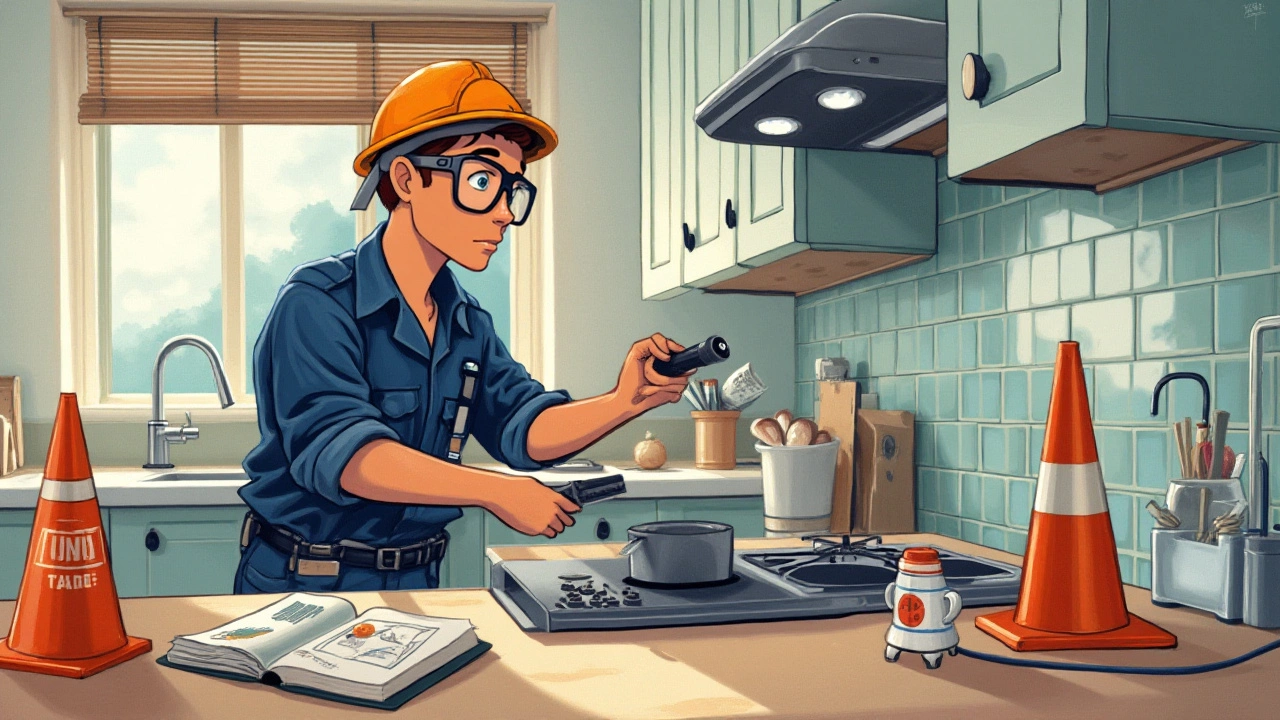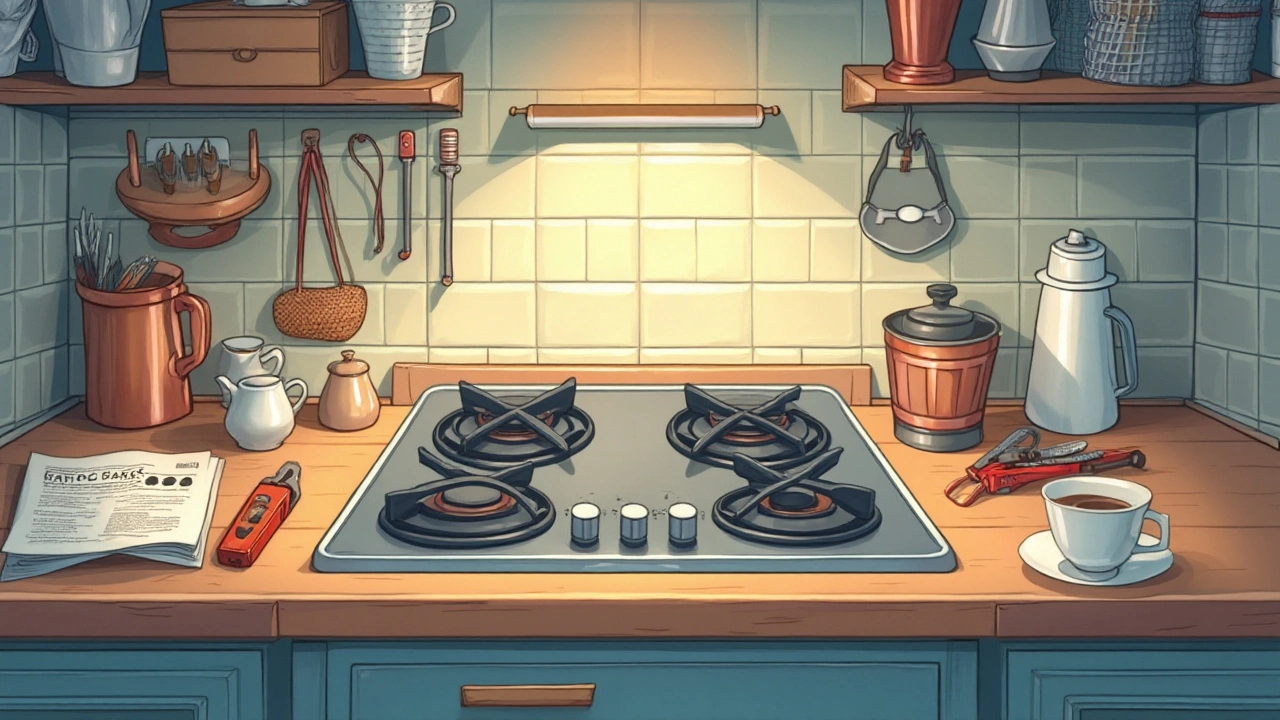When your kitchen's electric hob decides to call it quits, you're faced with the decision of how best to replace it. While some might feel the urge to embrace their inner handyman, others may wonder if professional help is needed. Replacing an electric hob isn't just about sliding the old unit out and plugging in a new one; there are safety issues and technicalities to consider. Knowing whether this task is suitable for a DIY project or requires an electrician’s expertise can make a world of difference, not only in the time spent but also in ensuring your kitchen remains a safe space for culinary adventures.
- Understanding Electric Hobs
- Tools Required for Replacement
- Safety Considerations
- When to Hire an Electrician
- DIY Replacement Tips
Understanding Electric Hobs
Electric hobs, a staple in modern kitchens, offer a fascinating blend of technology and convenience. With their smooth surfaces and sleek designs, they've transformed the way we cook. But what exactly lies beneath that shiny exterior? An electric hob typically consists of a ceramic or glass surface, beneath which are concealed electrical heating elements. These elements rapidly heat the surface and your pots, offering a reliable and consistent source of heat. Unlike gas stoves where you can visually tell the intensity of the flame, electric hobs offer digital displays or knobs to adjust the heat level through resistance changes in the elements. The understanding of these mechanisms is crucial for recognizing why repairs or replacements might be necessary.
Electric hobs come in various types, including induction, solid plate, and ceramic. Induction hobs, for instance, make use of a magnetic field to generate heat, which only heats the pan and not the hob surface directly. This innovation is celebrated for its energy efficiency and safety, as the surface remains cooler to the touch. Ceramic hobs, on the other hand, have heating elements beneath a heat-resistant glass. These are less costly than their induction counterparts but take slightly longer to cool down. A solid plate hob, often considered a budget option, uses electric coils that heat up and transfer warmth to the cooking vessel. Understanding these differences is necessary when deciding on a replacement hob, as it influences both the installation process and future utility bills.
"Electric hobs offer a new dimension of precision to cooking; they provide unparalleled control over temperature settings," notes a renowned chef from Culinary Academy.The technology behind electric hobs has evolved significantly over the years. Modern hobs are equipped with smart features like touch controls, timers, and even connectivity with other smart devices in your kitchen. This compatibility leads to improved user experiences and, quite remarkably, a higher level of cooking accuracy. These advancements not only enhance cooking efficiency but also cater to users seeking to streamline their kitchen chores.
You'll find that electric hobs are designed for longevity, yet like any other appliance, they do have their share of vulnerabilities. Common issues include malfunctioning controls, heating element failures, and thermal fuses that might blow. Recognizing these troubles helps in determining the depth of repair required. Some issues can be rectified by replacing component parts, while others might necessitate a total swap for a new unit. Keep in mind that while user manuals provide help in minor fixes, some technical problems need professional intervention, especially if they pertain to the electrical components.
Delving deeper, electric hobs have specific specifications concerning energy consumption and efficiency. Cooking on an electric hob can be economical depending on your electricity rates and your chosen hob's energy class. The Surface Efficiency Class, measured in kilowatt-hours (kWh), tells a lot about an electric hob's performance relative to energy use. The choice of cookware can also affect efficiency. For induction hobs, ferrous metal pots and pans are necessary because only they work effectively with the magnetic fields used to create heat. A simple kitchen magnet test can quickly ascertain the compatibility of your pots with an induction hob, an essential consideration for those looking to make the switch.
Tools Required for Replacement
Before diving into the actual replacement of an electric hob, gathering the right tools is crucial. One of the first things to keep in mind is that electric hobs, being intricate kitchen appliances, need precision tools for a safe and efficient replacement. The essential toolkit should include a screwdriver set, which is handy for detaching and securing screws of varying sizes and types. Depending on the model and brand of the hob, you might encounter different screw heads, so having a diverse set ensures you won't be caught off guard.
Electrical safety is paramount, and therefore, a voltage detector pen is another indispensable tool. This simple device helps ascertain whether the electric current is still active, preventing accidental electric shocks. Keeping your multimeter nearby can further assist in checking voltage levels and continuity, making sure wires are properly connected and current flows as required. An adjustable wrench is also valuable, especially when you need to maneuver and tighten any connections that might be bolted or clamped.
Next, you should have a wire stripper and cutter. These tools allow you to trim any excess wires and strip insulation effectively without damaging the core. Sometimes, during replacement, wires might need shortening or fitting into tighter spaces. On the off chance that your electric hob has a gas component for dual fuel hobs, it’s wise to have a gas wrench, as not all hobs are exclusively electric. It's essential to address both aspects seamlessly. A twist lock plug might come in handy if you're in a location where they're used to connect appliances directly to your home’s wiring.
When thinking about safety, insulating tape shouldn't be neglected. This tape is perfect for securing wire connections and preventing exposure that can lead to short circuits or electrical fires. Consider keeping a few sheets of protective sheeting or an old blanket to protect your kitchen counter from scratches or damages during the hob installation process. Such foresight ensures your countertops remain pristine.
As the renowned expert Bob Vila quips, "Certain home improvement tasks are great for the DIY-er, but when it comes to electricity, calling in the pros saves a lot of potential headaches." This advice rings especially true when considering the technical requirements of hob replacement.
Finally, don’t underestimate the utility of having a comprehensive installation manual or guide. This isn't just about showing you 'where to plug what,' but understanding the specific nuances and requirements for the electric hob model you’re handling. These manuals often contain step-by-step recommendations from manufacturers, ensuring you don’t miss any essential aspect during installation. While tools equip you physically, knowledge arms you mentally for a successful replacement.

Safety Considerations
When it comes to replacing an electric hob, safety should be the top priority for anyone tackling the task. These appliances are directly connected to your home's electricity supply, making the risks associated with improper installation significant. Ensuring that electric connections are handled correctly can prevent potential hazards such as electrical shocks, fires, or damage to your appliance. Before starting the replacement process, make sure the power is turned off at the mains. Lockout and tagout procedures ensure that someone doesn't inadvertently switch the power back on while the hob is being worked on. Respecting these safety protocols not only protects you but also sets the stage for a successful installation.
It's crucial to understand the wiring setup of your kitchen, which can vary based on the age of your home and its electrical system. The electric hob replacement involves dealing with high voltage wiring, usually on a dedicated circuit because of the power they draw. Familiarize yourself with the color codes of wires—traditionally live, neutral, and earth—a mistake here could spell disaster. Modern setups often use a junction box or terminal block, which simplifies connections but requires careful attention. Watch out for any signs of damage or wear on the cables, and replace them if needed, instead of trying to work around potentially dangerous conditions.
Professional electricians train for years to understand the intricacies of safe wiring, which is why hesitation about a DIY approach might actually be wise. If you feel unsure about any step, stepping back and consulting a certified electrician could save more than just your hob. Local electrical regulations often mandate professional installation for certain types of high-power appliances. Failure to comply could not only void warranties but may also leave you liable in the event of an incident. A flawed installation might not immediately show problems, but it could lead to malfunctions over time. Consumer safety organizations often highlight this, emphasizing the importance of professional oversight.
The physical safety of yourself and your home is complemented by proper personal protective equipment. Equip yourself with proper attire—insulated gloves and protective eyewear can minimize risk. Use tools that ensure safe handling of electrical components, like insulated screwdrivers. Testing the circuits with a trusted multimeter before touching them is a simple yet effective measure that shouldn't be overlooked. Maintenance checks on other components such as earthing and circuit breakers should form an essential part of your pre-installation assessment, being a proactive approach to preventing potential problems.
An electric hob isn't just a simple plug-and-play appliance. It requires a dance with regulations, technical know-how, and an unwavering respect for electricity. As noted by the Electrical Safety Foundation International, "Understanding the scope of the task and your own limitations can significantly contribute towards a safe installation." This understanding primes your project for not just functional success but a safe experience, all while keeping the charm of your kitchen intact.
When to Hire an Electrician
Deciding whether to hire an electrician for replacing your electric hob can be a tricky decision, heavily dependent on a few crucial factors. The first thing to consider is the complexity of your current setup. If you're looking at a straightforward switchover and your existing cabling is in good condition, some may feel confident going the DIY route. However, if your hob involves intricate connections or there's a need to upgrade old wiring, professional intervention is advisable. Faulty wiring can pose significant risks and an electrician not only ensures compliance with local regulations but brings peace of mind through their expertise.
Another aspect to consider is your familiarity and comfort with electrical appliances. While swiping out the old and bringing in the new sounds simple enough, it's essential to remember that wrong connections can lead to short circuits or potential damage to the new appliance. A survey by a home improvement magazine found that 40% of kitchen appliance malfunctions were related to improper installation. Avoid falling prey to such statistics by consulting an electrician when in doubt.
"Electricity is a powerful servant but a dangerous master," warns Professor Alex Miller from the Institute of Electrical Safety. "Understanding the intricate nuances of electrical installations is crucial for home safety."This quote serves as a reminder that handling electricity carries inherent risks and should never be taken lightly.
Cost is another relevant factor. While hiring an electrician can be an added expense, it often saves you money in the long run by preventing potential mishaps and ensuring your kitchen appliance operates at peak efficiency. An electrician will also guarantee that your newly installed hob complies with all safety and regulatory standards, a critical consideration that goes unnoticed in DIY installations.
If time is of the essence, an electrician’s services could be invaluable. With professional expertise, they can manage what might be an all-day project for a novice in a matter of hours. Imagine having a dinner party on the horizon, and an efficient swap becomes vital. Hiring a professional ensures this can be accomplished without last-minute chaos. Finally, consider hiring an electrician if you're moving into a new home where the wiring's condition is questionable. When you inherit electric setups whose history is unclear, expert evaluation is often the best course.

DIY Replacement Tips
Thinking of tackling the replacement of your electric hob on your own? Before you embark on this home improvement quest, it’s crucial to arm yourself with ample knowledge and preparations. Successfully replacing the unit without any professional intervention can be gratifying, yet it hinges on understanding some essential DIY tips. Consider the compatibility of your new hob with the existing setup in terms of size dimensions and electric specifications. Many assume a simple fit, but misjudgment in these areas can lead to setbacks or even the necessity for a costly new purchase. Remember that each manufacturer's design can slightly vary, sometimes requiring an adjustment in the existing cut-out in your countertop.
An accurate understanding of the wiring connections is imperative. Safety is paramount, and disconnecting the power supply before you start working is a non-negotiable step. The electrical connections for hobs can differ; some may have three wires, while others will have four. Ensuring you follow the correct installation specifics for your new appliance is vital for its proper functioning. It’s worth noting that according to a survey by the Energy Safety Service, mishandling of electrical tasks leads to a significant portion of domestic hazards in New Zealand. So here's where you might want to pause and reflect on whether calling that electrician isn't actually the wiser path.
As you gather your tools, consider a set that includes basic screwdrivers, a multitester for checking the electrical current, wire strippers, and possibly a saw if countertop adjustments are needed. A pro tip would be to mark the wires with tape as you remove them from the old unit; this ensures clarity and prevents confusion as you connect the new electric hob. Patience and methodical tracing of each step are virtues when working with electrical appliances. According to a well-cited guide from the Home Improvement Guild, "90% of DIY errors are a result of rushing or skipping steps."
Here’s a step-by-step approach to guide you through:
- Ensure all power supplies are safely disconnected to prevent any risk of electric shock.
- Remove the old hob carefully, observing how the wiring connects.
- Check that the new hob fits snugly into the countertop cut-out.
- Connect the wires precisely as indicated in the appliance manual, using your tape marks as a guide.
- Secure the hob by bolting it down as per the requirement specified by the manufacturer.
- Double-check every connection before powering up the unit.
- Finally, conduct a test run to ensure everything is functioning correctly.
Patience is your best ally in DIY projects of this nature. Should anything feel beyond your comfort level, don't hesitate to involve a professional. While the satisfaction of a successful replace might be tempting, the potential issues from incorrect electrical work can far outweigh the initial cost of a specialist's expertise. Approach each step with care, and you'll not only ensure a functioning kitchen appliance but also a safe home environment.


